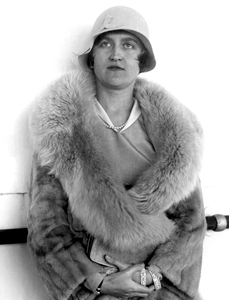
Huguette ClarkFor the past two decades, some 17,000 square feet of prime Fifth Avenue real estate have sat fully furnished, but empty. Once owned by eccentric heiress Huguette Clark, the three sprawling apartments at exclusive co-op 907 Fifth Avenue are now visited only by cleaning staff.
Clark spent the last 20 years of her life in hospitals despite reported good health, scarcely ever setting foot inside 907 Fifth Avenue or her seaside mansion in Santa Barbara, Calif. She also reportedly never spent a single night in the 12,766-square-foot Connecticut country house she bought in 1951. (That 52-acre estate in New Canaan is currently on the market for $24 million.)
Yet Clark’s properties were meticulously maintained. The Fifth Avenue spread is filled with dolls the heiress collected, and paintings by the likes of Monet and van Gogh. “It was like she had just walked out,” recalled Barbara Fox, who visited the units to do an appraisal for the estate — becoming one of the few living real estate brokers to ever set foot inside. “There were dolls everywhere.”
When 907 Fifth Avenue went co-op in the 1950s, Huguette Clark and her mother, Anna La Chapelle Clark, purchased the three spaces they were renting: Both of the apartments that comprise the eighth floor — giving them an eye-popping total of 10,000 square feet on that level — plus a half-floor unit on the 12th floor, the building’s top story. At some point, they added more bedrooms to their 12th-floor space, bringing it to roughly 7,000 square feet, said Key Ventures’ Larry Kaiser, who said he’s sold some 14 apartments in the building over the years.
Anna died in the 1960s, and Clark — Anna’s only surviving child — inherited all three apartments.
The Clark apartments comprise one of the largest holdings on Fifth Avenue, if not the largest. The three apartments will likely be put on the market separately, each fetching “tens of millions” of dollars, said Prudential Douglas Elliman’s Tristan Harper, who is listing a 3,300-square-foot two-bedroom on the ninth floor for $7.9 million. Brokers estimated that the Clarks’ 12th-floor apartment and the north-facing apartment on the eighth floor could sell for $25 million to $30 million each, while the other apartment on the eighth floor would likely go for $15 million to $18 million.
So Clark’s death last May at age 104 sent New York real estate observers into a frenzy of speculation about when her homes would hit the market. Clark, who was married and quickly divorced in the 1920s, had no children, and the will unveiled at the time of her death left nothing to her surviving family. But a second will — this one more beneficial to her relatives — surfaced late last year, plunging the estate into litigation. Just before press time, a Manhattan surrogate court suspended Clark’s longtime accountant, Irving Kamsler, and her lawyer, Wallace Bock, from their posts as executors of her estate, amid allegations that they engaged in tax fraud while handling her affairs. (Both deny any wrongdoing.)
John Dadakis, a partner at Holland & Knight, the law firm administering one of Clark’s wills, said the Manhattan apartments will likely go on the market early this year. If the properties are sold before the legal disputes are ironed out, the proceeds will be held in escrow, he said. In the meantime, The Real Deal examined original floor plans to find out what lies behind these long-locked doors.
“Every broker worth his salt is going to want to be able to market these apartments,” said Andrew Alpern, a Manhattan-based architectural historian who has studied Clark’s holdings. Click on the image below for a closer look at what we uncovered.

